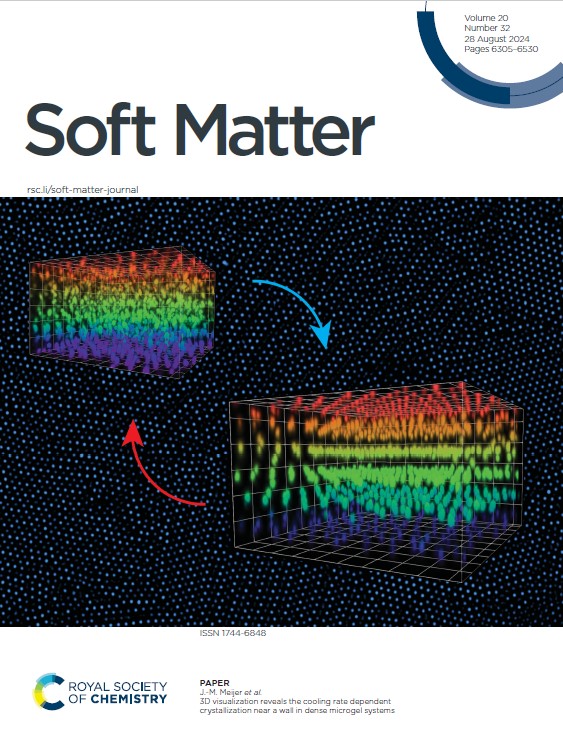Max Schelling Publishes Study on Cooling-Dependent Crystallization in Microgels in Soft Matter
Max Schelling, PhD student in the group of Janne-Mieke Meijer (Soft Matter and Biological Physics) published a manuscript that made it to the inside cover of the Journal Soft Matter. In the study Schelling investigated the cooling rate dependent crystallization near a wall in dense microgel systems.
![[Translate to English:] [Translate to English:]](https://assets.w3.tue.nl/w/fileadmin/_processed_/6/4/csm_Schelling_Max_AP_PROM_PO_AS_0575_30ac322357.jpg)
The art of crystallization
Crystallization is the process of solidification of a substance where the atoms or molecules organize into a structure known as a crystal and is an important process in both nature and technology. Typical crystalline materials are ice and most metals that crystallize upon cooling from the liquid state. The exact conditions during the crystallization process influence the type of crystal that forms. A difference in the conditions is for instance the reason why snowflakes form in the sky but ice cubes in the freezer. However, by controlling the crystallization, desired crystal material properties can be achieved, such as during the hardening and tempering of steel.

Exploring crystallization through colloidal "big atoms"
Studying crystallization process on an atomic level, however, is challenging because the atoms are tiny and move very fast. Instead, in this study Schelling used small particles, called colloids, that are about 10,000 times larger than atoms. These colloids behave like "big atoms" because they form similar liquids and crystals as atoms but are much easier to observe on a single-particle level with an optical microscope. In addition, the crystals that colloids form are also of interest. A beautiful natural colloidal crystal example are opals. The bright colors of opals are caused by the reflection of visible light by the colloidal crystal planes.
To study the crystallization process in detail, Schelling used a special type of colloid – microgels – that can change in size in response to a temperature change when put into water. The total volume occupied by the microgels determines whether the particles form a liquid or a crystal. Therefore, by simply heating and cooling the microgels, Schelling controlled the phases of the microgels and could follow the crystallization process from the liquid state.
The impact of cooling rates on crystal formation
Schelling is using this control to study how the rate of cooling affects the type of crystal that the particles form near a wall. The wall is known to influence the crystallization process but how it does so exactly was the question Schelling addressed. He found that the cooling rate controls both the kind of crystals that form as well as their orientation. The findings of his study help to understand crystallization better and the insight is useful for optimizing crystallization protocols to obtain desired material properties. For instance, the microgel crystal studies here are of interest as switchable photonic crystals for sensor and optical applications. However, the fundamental insight gained in his study, is also valuable for atomic crystals and can lead to major technical developments in material science reducing the use of energy and resources.
If you want to know more about this research, or if you are interested in the outcome or next steps, please contact Janne-Mieke Meijer or Max Schelling. You can read the full article here.
About Soft Matter Journal
Soft Matter provides a unique forum for the communication of significant advances in interdisciplinary soft matter research. There is a particular focus on the interface between chemistry, physics, materials science, biology and chemical engineering. Research may report new soft materials or phenomena, encompass their design, synthesis, and use in new applications; or provide fundamental insight and observations on their behaviour. Experimental, theoretical and computational soft matter approaches are encouraged.
Latest news
![[Translate to English:] [Translate to English:]](https://assets.w3.tue.nl/w/fileadmin/_processed_/6/2/csm_universiteit%20jos%20keurentjes%20energie%202_d469fe3b2f.jpg)
![[Translate to English:] [Translate to English:]](https://assets.w3.tue.nl/w/fileadmin/_processed_/2/2/csm_Pre-EditLeviBaruch-0003_558369f155.jpg)
![[Translate to English:] [Translate to English:]](https://assets.w3.tue.nl/w/fileadmin/_processed_/7/d/csm_Boutin%20Banner%20image_165e239d2b.jpg)